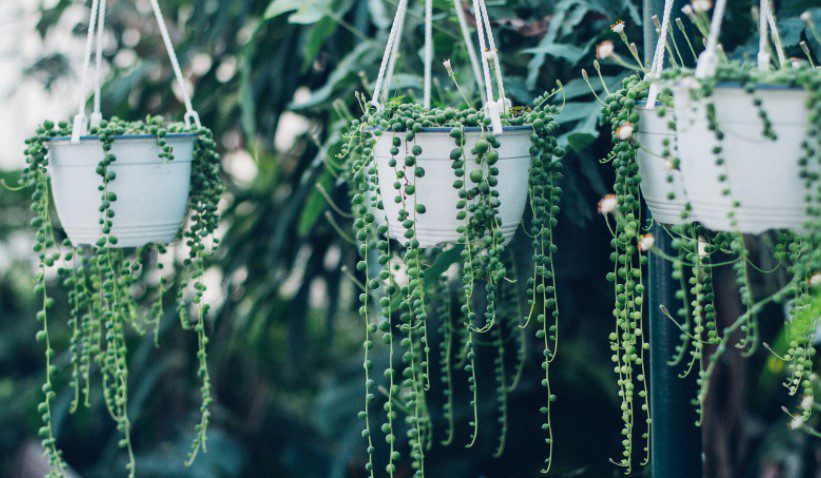Hanging Succulents
Many people choose to create a hanging succulents garden to add color to their backyard. Colorful succulents and ferns are the most popular variety of hanging gardens.
Succulents of vibrant gold, blue and green, are all-season plants. They require little water and are easy to look after, thriving in direct sun.
All you need is a self-draining hanging basket and some premium potting mix that holds water well.
Some people hang the succulents off their Colorbond fences or under palm trees near the swimming pool.
Ferns serve a different purpose. They grow best in a protected area, away from the wind and heat, and add a softness to the site.
They look beautiful on a balcony or verandah, or a sunroom where it only gets the morning sun.
Other alternatives that brighten up the garden are seasonal flowering plants like marigolds, lobelias, or petunias.
The green and cream climbing ivy also look good in a hanging garden. Each hanging garden needs a little liquid fertilizer every four to six weeks and occasional watering.
Hanging baskets can be constructed from many different succulents and are relatively easy to maintain.
Hanging baskets are made from succulents that have a pendulous growth habit. These plants aren’t the first to come to mind when you think of succulent plants.
4 Hanging Succulents Selection
Burro’s tail (Sedum organianum) is the most well-known member of this group.
Burro is a slow-growing plant. Its tail is made of porcelain blue jelly-bean leaves. These will eventually grow into geotropic chains up to 3 feet in length.
Burro’s mature tail looks formidable and more like an exotic ornament from a Chinese palace than any other plant. It will eventually become a family heirloom.
A string of hearts and string with beads are the most prominent succulent plants for hanging baskets. A string of hearts (Ceropegia linearis woodii) is a delicate, heart-shaped plant connected by thin, tooth-floss-like strands.
A string of hearts is the perfect gift for your gardening partner or significant other. A string of beads (Senecio Rowleyanus), placed among other baubles, could easily be mistaken for a string pearl-sized, polished globes made from pale green semi-precious stones.
The Kalanchoe pumila, a gray-leafed, pink flowering succulent sought-after for hanging baskets, is perhaps the most desirable. Kalanchoe pumila was planted in large quantities as a full sun ground cover at the Getty Center Garden in Brentwood.
This plant can only flower reliably in partial sunlight due to the Valley’s hotter climate.
Hanging baskets made of wire or wood can be easily prepared for use.
Green sphagnum Moss is the only soil or medium that’s required for a successful garden. It can be purchased in bags or bales from any nursery or garden center.
After soaking the sphagnum-moss in water until it is saturated, dry it and then cover the basket with it.
Once your moss lining has grown to several inches thick, your plants can be placed in the appropriate mossy beds.
You can easily remove containerized plants you brought home for your hanging garden and put them in the basket.
These and other hanging succulent plants can be seen at David Bernstein’s California Nursery Specialties (19420 Saticoy Blvd.). The nursery is open to all on Saturdays and Sundays from 11 a.m. – 5 p.m.
You can use any plant that has trailing tendencies to make a hanging basket. Coleus is a well-known and beloved house plant that has multicolored leaves.
It’s also a trendy choice for hanging baskets on the patio. There are new coleus varieties available, with brightly colored leaves that are more sun-tolerant than traditional coleus. They often have scalloped leaves.
TIP OF THE WEEK
Hanging-basket enthusiasts love to plant hanging succulents annuals in six-packs. Take the small plants out of their plastic containers and place them in a hanging basket.
This task is a great one for trailing annuals like petunias, impatiens, and lobelia. Plant them now, and they will be a riot in color in just a few weeks.
Sprinkle slow-release fertilizer pellets all over your plants to eliminate the need for fertilization. Some formulations can last up to six months or longer.
You may need to fertilize your hanging succulents annually more often than usual because of the constant watering required by hanging baskets.
The fertilizer will disintegrate faster than if it were in an earthbound container.



























Comments are closed.